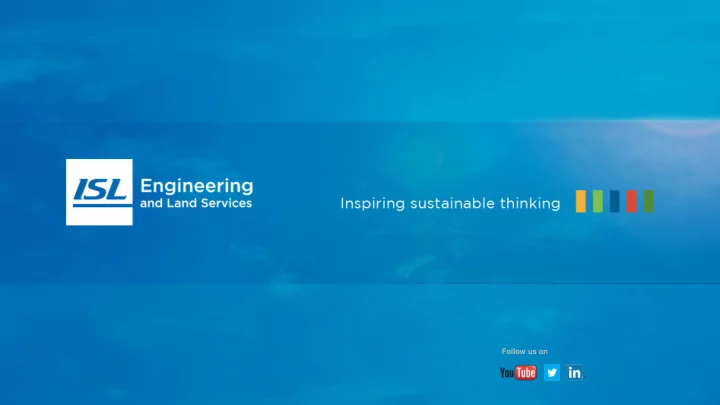

Follow us on
Town of Redcliff – Inflow-Infiltration Management Strategy Sanitary Sewer System Level of Service Discussion December 8, 2014 2
Study Overview to Date • Hydrodynamic (MIKE URBAN) model developed of existing sanitary sewer system • Sewer flow monitoring conducted • Smoke testing and CCTV inspection conducted • Sanitary model calibrated with flow monitoring data • Inflow-infiltration rates observed reviewed • System assessments undertaken for several scenarios • Upgrades developed for each scenario 3
Existing Sanitary System 4
5
Modelling Process • Compile existing sanitary system in model • Fill in missing data • Compile flow monitoring data • Calibrate model for dry and wet weather 6
7
8
9
10
11
Flow Monitoring Observations • No major backup events were flow monitored in 2014 • Northwest exhibited significant wet weather response (very peaky, suggesting inflow) • South trunk also showed fairly significant response (pattern a very classic mix of inflow and infiltration) • Compile flow monitoring data • Calibrate model for dry and wet weather 12
Drainage Surveys • Initial survey at open house on lots with sewer backup • Mailed out surveys requesting information on: • Lots with sewer backup • Presence of inflow-infiltration contributors such as: • Roof leaders • Sump pumps • Weeping tiles • Etc. as well as their discharge location (sanitary is bad) 13
Drainage Survey Results 14
Drainage Survey Results 15
Drainage Survey Results 16
Drainage Survey Results 17
Drainage Survey Results 18
Drainage Survey Results 19
Drainage Survey Results 20
Drainage Survey Results 21
Smoke Testing • Smoke testing was conducted in August 2014 • Involved filling sequential sections of the sewer system with non- toxic smoke • Smoke observation locations were noted (logic is where smoke comes out, water gets in) • Items observed included roof drains, cleanout caps, manholes, etc. 22
Smoke Testing Results 23
CCTV Inspection • Portions of the sanitary sewer system were previously CCTV inspected in 2012 • Additional sections were inspected in 2014 • Looking for pipe condition issues, high inflows, debris accumulation, etc. • Some issues with pipe condition were noted (joint displacement, service connection issues), as well as some higher flow areas (NW), and debris accumulation 24
CCTV Results 25
CCTV Results 26
Assessment Scenarios • Constant inflow-infiltration rate of 0.28L/s/ha (standard for new development per Alberta Environment) • 1:50 year, 4 th quartile 24 hour Huff rainfall distribution (used by City of Calgary – represents a typical distribution for heavy sanitary response) • July, 2013 Thunderstorm (derived from Environment Canada radar imagery and Seven Persons rain gauge using geostatistical methods) 27
Assessment Scenario Inflow-Infiltration Rates 28
Assessment Scenario Results 29
Assessment Scenario Results 30
Assessment Scenario Results 31
Assessment Scenario Results 32
Assessment Scenario Results 33
Assessment Scenario Results 34
Assessment Scenario Results 35
Assessment Scenario Upgrade Summary • Upgrades were developed for each scenario • 0.28L/s/ha scenario – no upgrades • Huff storm • South trunk upgrades • NW upgrades including lift station pumps • Minor upgrades in Town core • July, 2013 Thunderstorm • Similar to Huff storm plus: • Extended south trunk upgrades • Significant Town core upgrades • Major NW upgrades including new lift station and entire receiving sewer 36
Upgrades 37
Upgrades 38
Upgrades 39
Upgrades 40
Upgrade Cost Comparison • Previous study had existing conveyance upgrades at ~$11.0M 41
Outfall Line to Medicine Hat • Line from SE Redcliff to Medicine Hat has ~165-170 L/s capacity • Capacity is exceeded under existing conditions (notwithstanding future growth) • Could twin dedicated line to Medicine Hat (~2,500m), but after that upgrades are unclear • Possible off-site levy charges • Possible upgrades to gravity sewer to Brier Park Lift Station • Possible upgrades to Brier Park Lift Station • Possible upgrades from Brier Park Lift Station to WWTP 42
Outfall Line to Medicine Hat • Information from City has been unclear to date • Reference was made to a long term trunk upgrade that either upgrades existing alignment or goes around to north (City was talking $10.0M+ for this upgrade) – it is not in their 25 year plan • Continuing efforts to get a cost from the City to take additional flows • Depending on this information, other upgrades may be considered to optimize capital spending (e.g. Redcliff starts treating wastewater from growth areas with independent discharge upstream of Medicine Hat) 43
Next Steps • Town to confirm desired level of service • Existing system conceptual designs / costs to be developed • Future system upgrade conceptual designs/costs to be developed • Further engagement with City of Medicine Hat to review options to deal with downstream capacity issues • Inflow-infiltration reduction measures to be recommended • Report to be prepared 44
Questions and Discussion 45
Recommend
More recommend